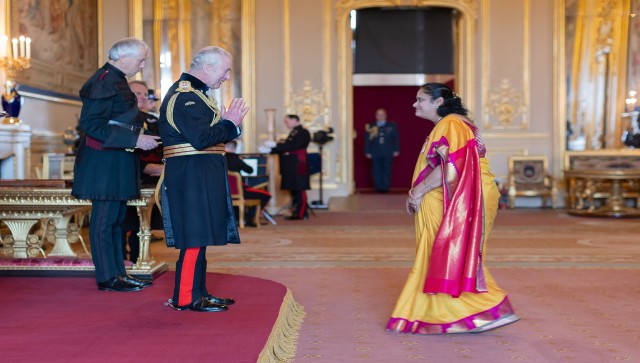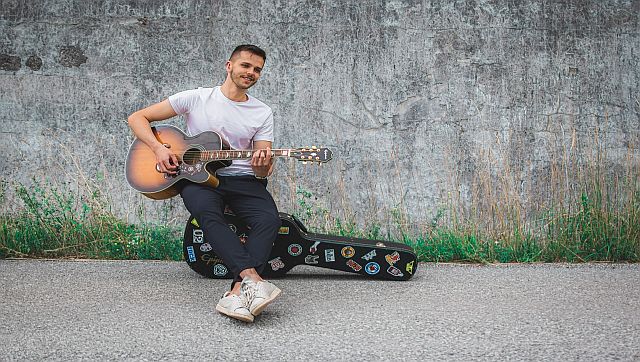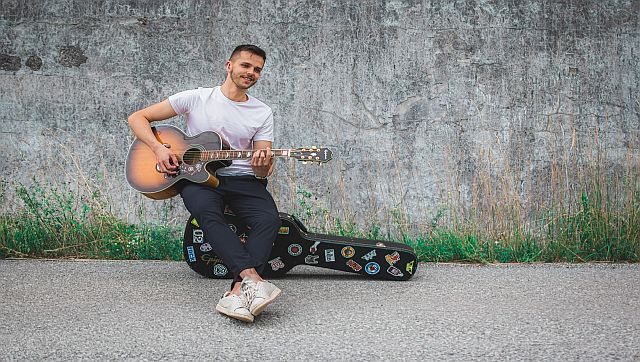Jacob Collier tends to give long, elaborate answers. We suppose that’s natural for a musician who tends to make long, elaborate songs. Genius, prodigy, autodidact, Grammy winner and YouTube phenomenon are just some of the adjectives regularly used to describe the 25-year-old London-based British musician, who shot to fame as a teenager when videos of him performing complex cover versions of classic tunes went viral online.
Those videos impressed legendary music producer Quincy Jones enough to offer Collier his services. Collier, who was 19 at the time, decided to sign on to Jones’ management company instead. This was probably because he’s as independent-minded as he is talented, and as ambitious as he is prolific. He sang, played every instrument (many of which he taught himself), composed, arranged, produced and recorded every track on his award-winning 2016 debut album In My Room on his own.
Then he followed that up with a one-man-show world tour where he, with the aid of technology such as looping, performed it all solo in concerts. Collier’s currently two volumes into his grand 50-song, collaboration-heavy four-album project Djesse, which he named after his initials. The first volume was made with Dutch non-classical orchestra Metropole Orkest; both collections feature a number of guests including guitar legend Steve Vai and his mother, violinist and music teacher Suzie. We interviewed Collier who will perform in Mumbai at the National Centre for the Performing Arts on 17-18 September, about YouTube, jazz, and how he puts together a set list. Edited excerpts:
You’re often described as a YouTube sensation. YouTube is something of a strange beast for the music industry. It’s helped a lot of artists find their audiences but at the same time there are issues such as the value gap and the prevalence of paid views. What role has YouTube played in your career and how do you perceive these criticisms?
I suppose for me as a kid, the first thing that YouTube was valuable for was learning. I would have an idea to explore, say, Indian music, for example, and I would dig around and find one musician who would lead me to another and another. I was able to dig into these concepts and fall in love with them. At that age, I wasn’t even thinking about value gap. I just was thinking, this is so cool, this is so exciting.
I suppose I created music in a similar fashion. I was able to spend time doing things that I wanted to do and I could do them on my own terms. I didn’t have to sign with a recorded label or a management company or anything like that. I was able to have an idea, build the idea and share the idea. I didn’t even think about trying to make money from that until relatively recently.
For me, the wonderful thing about YouTube is that it really grants people the freedom to be themselves and also do things their own way, to take time to learn and then to express things and to share and collaborate all over the planet, in a way that wasn’t possible five or 10 years before. I guess now the challenge is how do we forge some kind of sustainable business model for people who are creating things but who aren’t having careers where they’re able to tour or they’re able to fund having a band and stuff. It’s a very important and a very difficult question.
You’ve been classified as a jazz musician even though your music incorporates elements from a very wide range of genres. Are you okay with that?
I didn’t really decide to be a jazz artist. I was making music that made sense to my ear. But in the last few years before I started making videos, I got very interested in jazz. Not necessarily because I like jazz music but [because> I loved the idea that you could learn about harmony and rhythm and melody in almost like a classical way along the trajectory of a music that was based in improvisation. I’ve always loved improvisation.
I guess that was what really got me into jazz, thinking ‘I love harmony, I love chords, I love rhythm and groove, and I love melody” [and> it’s possible for all these ingredients to exist in a space together and you can improvise. It was like, ‘Oh this is all of the things I really like about music.’ I’ve always been very much self-taught so a lot of that was self-exploration.
To be honest, a lot of musical theory stuff was rather off-putting as a child. By the time I became interested in jazz, I resonated more with the ideas. I [then> began to take these songs that I really liked, like Stevie Wonder songs, and I’d push them to the extreme. I’d use all the strange vocabulary I had been collecting whether it was from classical music or folk music or electronic music or jazz, and I’d put them together and release them.
I think probably the reason people felt it was jazz is because jazz is a very broad term nowadays. It’s possible to be a jazz musician and play rock n’ roll or to make beats. I’ve always believed that jazz is not a really a means to an end, it’s more like a way of thinking about music.
But I wouldn’t say I’m a jazz musician. I aim to be a musician, full stop.
You seem to be the kind of musician who has multiple ideas when you’re working on a track. How do you decide which ideas to keep?
It’s hard. If I turn on the ideas tap, I get lots at once. That was one of the reasons I wanted to challenge myself with this 50-song album. I love the kaleidoscopical feeling of pushing ideas together. I almost feel like a chemist. Sometimes ideas become more exciting if you put them together and there’s some kind of chemical reaction.
I’m also a firm believer that when you break all the complexities down, music should be something simple. There’s always that balance with simple and complex. I create music how I see the world. Even a flower is an extremely complex thing. It’s almost unbelievable. There are all these very complex mechanisms. But it’s also just a flower.
You’ve gone from recording on your own and staging the One-Man-Show to making collaboration-heavy albums and touring with a three-piece band. What’s the transition been like?
It was a massive challenge, specifically [working with> the orchestra in Djesse Vol. 1. It’s a massive body of humans, 60 or 70 people making music at once and I have to give them music to play. That whole experience was really wild because I’d listened to classical music and pop music and jazz which used the sound of the orchestra but the feeling of putting your own pen to your own paper and writing that music out is very different. In some ways it was also a very natural step. Because I’d done In My Room, which was a one-man album, and the One-Man-Show world tour. I wanted to expand my musical horizons by working with others and using other people’s imaginations to knock mine a bit. I wanted to scale the One-Man-Show into something that felt like it had more limbs, more gears. I was a little bored of the idea that I would walk on stage and I would build these loops and it was quite mathematical and the whole thing was quite structured. I really wanted to be able to improvise on stage. Jamming is what I was missing with the One-Man-Show even though it was really fun to be running around the circle and looping different instruments on top of each other. Something human felt like it was missing.
I also didn’t want to rebuild the whole thing from scratch. So rather than change the One-Man-Show completely, I got rid of all the looping stuff and I found three multi-instrumentalists. We rotate around the stage. It’s a very dynamic feeling because you’re able to experience all these different musical genres and sounds within the space of quite a short period of time. It feels kind of natural because the musicians are able to straddle these sounds but we can also just jam.
For me, one of the most exciting things of all is ‘playing’ the audience like a musical instrument. Often times, people in the audience want to sing and they want to clap and many of them are also musicians so it’s an amazing experience for me just to experiment with that. Just to see how far you can push people in a room, making music and almost like improvising together.
You work a lot with technology. What’s your favourite of all your musical gadgets?
One thing I just love, which was invented for the One-Man-Show tour but I still use it today is this vocal Harmonizer instrument. It was created with a friend of mine — Ben Bloomberg at MIT in Boston — a few years ago. The idea is that I can sing a note and I can then play more notes on a keyboard and what happens is that every note is sung by my voice in real time. So it’s almost like I can improvise as a choir. It essentially harmonises whatever you sing so it’s almost like an extension of my voice.
You’re pretty prolific. When you’re putting together a set list, how do you choose what to play and does it change with every show?
It does actually, a lot. I’ve always been interested in having lots and lots of songs to choose from and then being able to play whichever songs feel right on one gig. Trying to play all three albums at once isn’t possible obviously. It’s about choosing the moments from each album that mean the most and making the experience feel good. Because the whole thing is almost like telling a story, so you can’t just put all the good bits next to each other and hope for the best. You have to make it a narrative that has ebbs and flows.
That’s the cool thing about having lots of material. You can make those decisions as you go. Today, I’m feeling a bit funky so we’re going to play lots of funky stuff. Tomorrow, I might feel like just singing some songs so we might do some slower songs.
Amit Gurbaxani is a Mumbai-based journalist who has been writing about music, specifically the country’s independent scene, for nearly two decades. He tweets @TheGroovebox


)




)
)
)
)
)
)
)
)